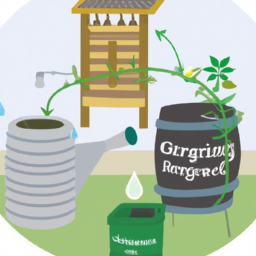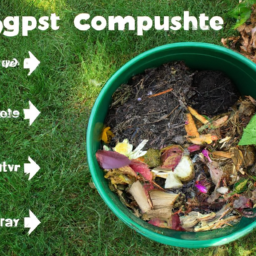Hey there!
Looking to create an eco-friendly garden without breaking the bank? Well, you’re in luck! In this article, I’ll share some budget-friendly tips and tricks to help you achieve your green oasis.
From affordable gardening tools to sustainable composting options, we’ll cover it all.
Plus, we’ll explore energy-efficient outdoor lighting and recycled planters to make your garden even more eco-friendly.
So, let’s get started on creating your dream garden without breaking the bank!
Affordable Gardening Gloves and Tools

I’ve found some great options for affordable gardening gloves and tools that are perfect for creating an eco-friendly garden on a small budget. When it comes to gardening, having the right tools is essential. And with these affordable options, you can get started without breaking the bank.
For gardening gloves, one affordable option is the Atlas Nitrile Touch Gloves. These gloves provide excellent grip and protection, making them ideal for handling plants and soil. They’re also machine washable, which means you can reuse them multiple times. Another affordable choice is the G & F MicroFoam Nitrile Coated Gloves. These gloves are lightweight, breathable, and offer great dexterity, allowing you to easily handle delicate seedlings.
When it comes to gardening tools, the Fiskars Softouch Garden Tool Set is a great option. This set includes a trowel, transplanter, and cultivator, all made with durable materials. Another affordable choice is the Esschert Design Garden Tool Set. This set includes a trowel, fork, and weeder, perfect for various gardening tasks.
Creating an eco-friendly garden doesn’t stop at affordable gloves and tools. It also involves using affordable seedlings and natural pest control methods. By opting for affordable seedlings, you can save money while still enjoying a beautiful garden. And by using natural pest control methods such as companion planting and homemade sprays, you can protect your garden without relying on harmful chemicals.
Eco-Friendly Watering Solutions

To continue our discussion on creating an eco-friendly garden on a small budget, let’s explore affordable and sustainable watering solutions.
When it comes to watering your garden, there are two key methods that can help conserve water and reduce your water bill: rainwater harvesting and drip irrigation.
Rainwater harvesting is a simple and cost-effective way to collect and store rainwater for later use in your garden. You can install a rain barrel or a larger cistern to capture rainwater from your roof. This water can then be used to irrigate your plants, reducing the need for tap water. Not only does rainwater harvesting save money, but it also helps to reduce the strain on local water sources.
Another eco-friendly watering solution is drip irrigation. This method delivers water directly to the roots of your plants, minimizing water waste through evaporation or runoff. Drip irrigation systems are affordable and easy to install, making them a great option for gardeners on a budget. By providing a slow and steady supply of water directly to the plants, drip irrigation ensures that each plant gets the right amount of water it needs, promoting healthier growth and conserving water in the process.
Incorporating rainwater harvesting and drip irrigation into your garden can significantly reduce your water consumption and help you create a more sustainable and eco-friendly space. With these affordable and efficient watering solutions, you can keep your garden thriving while being mindful of the environment and your budget.
Sustainable Composting Options

Moving on from our discussion on eco-friendly watering solutions, let’s now explore sustainable composting options to further enhance the environmental friendliness of your garden. Composting is a great way to reduce waste, improve soil quality, and promote a healthy ecosystem in your garden.
Here are four sustainable composting options to consider:
Vermicomposting: This method involves using worms to break down organic waste into nutrient-rich compost. Vermicomposting has several benefits, including faster decomposition, improved aeration, and increased microbial activity in the soil.
DIY Composting Bins: Building your own composting bin is a cost-effective and eco-friendly option. You can use materials such as wooden pallets or wire mesh to create a structure that allows for proper airflow and decomposition. DIY composting bins are customizable and can fit in small spaces, making them ideal for gardens with limited area.
Kitchen Composting: You can start composting right in your kitchen by collecting food scraps like fruit and vegetable peels, coffee grounds, and eggshells. These kitchen scraps can be added to your compost pile or vermicomposting bin to create nutrient-rich compost for your garden.
Grass Clippings and Leaves: Instead of throwing away grass clippings and leaves, use them as composting materials. These organic materials are rich in nitrogen and carbon, which are essential components for a healthy compost pile.
Energy-Efficient Outdoor Lighting

Continuing the conversation about sustainable practices in the garden, let’s now delve into the topic of energy-efficient outdoor lighting.
When it comes to lighting up your garden, it’s important to choose options that are both eco-friendly and cost-effective. One way to achieve this is by opting for low wattage bulbs. These bulbs consume less energy while still providing sufficient illumination for your outdoor space. By using low wattage bulbs, you can reduce your energy consumption and lower your carbon footprint.
Another great option for energy-efficient outdoor lighting is solar-powered lamps. These lamps harness the power of the sun during the day and use it to illuminate your garden at night. Solar-powered lamps aren’t only environmentally friendly but also extremely convenient as they don’t require any wiring or electricity. They simply charge during the day and automatically turn on at night.
With solar-powered lamps, you can enjoy a beautifully lit garden without worrying about electricity bills or the environmental impact.
Recycled Planters and Containers

For the next aspect of creating an eco-friendly garden, let’s explore the use of recycled planters and containers. Not only is this a great way to repurpose materials and reduce waste, but it can also add a unique and creative touch to your garden.
Here are four ideas for upcycled garden decorations and repurposed gardening supplies:
Tin cans: Don’t throw away those empty tin cans! They can be easily transformed into charming planters. Clean them thoroughly, punch some drainage holes in the bottom, and paint them in vibrant colors. You can even use stencils or tape to create interesting patterns.
Wine barrels: If you have an old wine barrel lying around, give it a new purpose as a planter. Cut off the top and fill it with soil to create a rustic and eye-catching container for your plants. It’s a great way to add a touch of elegance to your garden.
Wooden pallets: Turn old wooden pallets into vertical planters by attaching small pots or even repurposed plastic bottles. Lean the pallet against a wall or fence for a unique and space-saving garden display.
Broken ceramics: Instead of throwing away chipped or broken ceramic pots, use them as decorative accents in your garden. Break them into smaller pieces and arrange them around your plants to create a beautiful mosaic effect.
Frequently Asked Questions
What Are Some Affordable Alternatives to Traditional Gardening Gloves and Tools?
When it comes to gardening on a tight budget, finding alternatives to traditional gloves and tools is essential. There are affordable options like using old clothes or repurposing household items as gardening gloves, and utilizing DIY tools made from recycled materials.
How Can I Reduce Water Consumption in My Garden While Still Keeping My Plants Healthy?
To reduce water consumption in my garden while keeping my plants healthy, I’ve found some helpful tips and tricks. By using mulch, watering deeply but less frequently, and choosing drought-tolerant plants, I can conserve water effectively.
What Are Some Sustainable Options for Composting in a Small Garden Space?
When it comes to sustainable composting methods in a small garden space, there are a few options to consider. You could try vermicomposting or using a compost tumbler. Also, choosing eco-friendly fertilizers can make a big difference.
How Can I Choose Energy-Efficient Outdoor Lighting Options for My Eco-Friendly Garden?
When it comes to energy-efficient outdoor lighting options, I’ve found that creating a solar-powered garden lighting system is both practical and eco-friendly. It’s a great way to save money and reduce your carbon footprint.
Where Can I Find Recycled Planters and Containers for My Garden, and How Can I Repurpose Household Items for This Purpose?
I love finding recycled planters and repurposing household items for my garden. There are so many great sources for recycled planters, and it’s amazing what you can create with items you already have at home!
Conclusion
Creating an eco-friendly garden on a small budget isn’t only possible but also rewarding.
By investing in affordable gardening gloves and tools, using eco-friendly watering solutions, opting for sustainable composting options, choosing energy-efficient outdoor lighting, and using recycled planters and containers, you can create a beautiful and environmentally-friendly garden without breaking the bank.
With a little creativity and resourcefulness, you can make a positive impact on the planet while enjoying the beauty of nature in your own backyard.